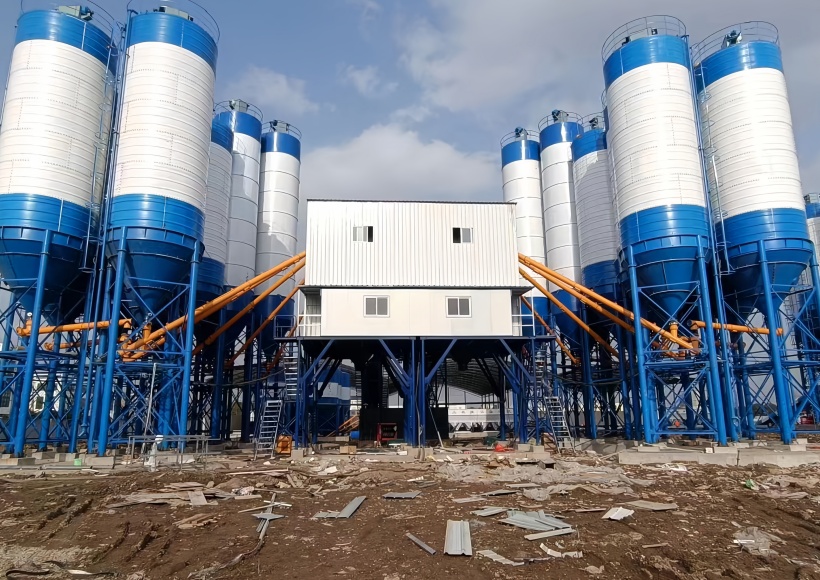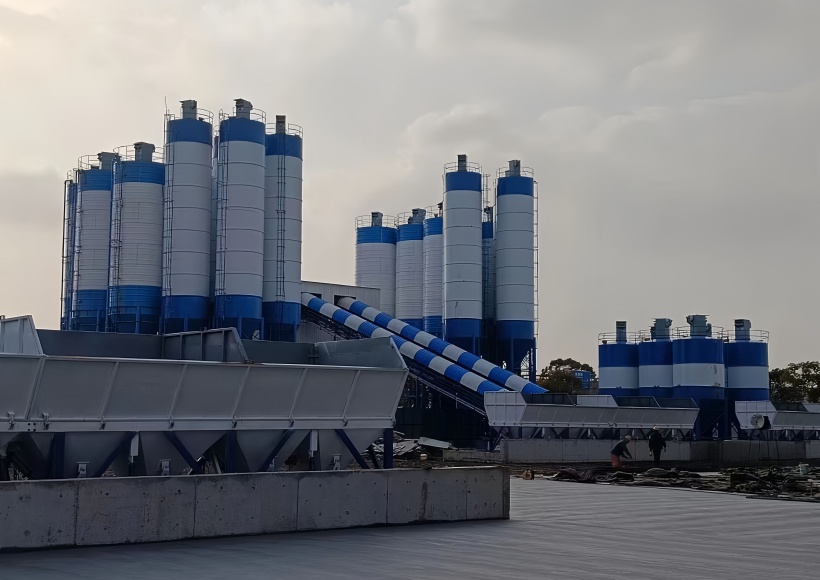In high-speed railway construction, concrete quality is directly related to the safety and durability of the structures. As a critical component of high-speed railway construction, concrete mixing plants must meet technical standards far exceeding those required for ordinary commercial concrete production. This article will provide an in-depth analysis of the four core technical requirements for high-speed railway concrete mixing plants.
1. Ultimate Uniformity: The Technical Implications of the Ultra-Long Mixing Process
Core Technical Indicators:
- Minimum Mixing Time: ≥120 seconds
- Homogeneity Requirements: Strength Coefficient of Variation ≤5%
- Workability Maintenance: Slump Loss ≤20mm/h
In-Depth Technical Analysis:
The concrete mix design used in key high-speed railway structural components (CRTS III track slabs, prestressed box girders, bridge piers, etc.) is complex, and the adequate dispersion of high-efficiency water reducers and fine admixtures is crucial. The 120-second mixing time is the minimum limit verified through fluid dynamics simulations and extensive testing, ensuring:
- Full wetting of cement particles and balanced hydration reaction
- Uniform distribution of water-reducing agent molecules in the system
- Stable formation of a microbubble system
- Fundamentally eliminating segregation and bleeding

II. Precision Metering System: A Technological Breakthrough in Dynamic Precision Control
Accuracy Standard Comparison Table:
Material Category High-Speed Rail Standard (Dynamic Error) General Commercial Standard (Static Error) Technical Challenge
Sand and Gravel Aggregates ≤±2% ≤±2% Large material flowability variations make dynamic control difficult
Cementitious Materials ≤±1% ≤±1% Powder adhesion, residue, and inertia affect dynamic accuracy
Mixing Water ≤±1% ≤±1% Pipeline pressure fluctuations affect dynamic accuracy
Chemical Admixtures ≤±1% ≤±1% High viscosity and small dosage make dynamic control difficult
Key Points on Dynamic Precision Technology:
Dynamic precision control is a core indicator for measuring the technical level of a mixing plant. Unlike static accuracy, dynamic accuracy reflects:
- The stability of the feeding system during continuous operation
- Real-time sensor response capability (sampling frequency ≥ 100Hz)
- Advanced control system algorithms (adaptive PID control)
- Anti-interference design of the mechanical structure
III. Full-Process Digitalization: Quality Traceability and Intelligent Early Warning System
Data Interconnection Architecture:
1. Real-Time Data Acquisition Layer
- Complete production data for each concrete batch
- Equipment operating status monitoring
- Environmental condition monitoring (temperature, humidity)
2. Cloud Processing Layer
- Big data analysis and trend prediction
- Intelligent identification of abnormal patterns
- Multi-dimensional quality report generation
3. Application Interaction Layer
- Real-time display in the owner's monitoring center
- Mobile warning information push
- Data sharing with supervision units
Intelligent Early Warning Mechanism:
- Level 1 Warning (Parameter Deviation): Audible and visual alarms, continuous monitoring
- Level 2 Warning (Trend Abnormality): SMS notification, manual intervention
- Level 3 Warning (Severe Exceedance): Automatic shutdown, quality traceability

IV. Raw Material Stability: Pre-emptive Management of Source Control
Cement Aging Technical Specifications:
- Temperature Control: Inlet Temperature ≤ 60°C
- Aging Time: ≥ 72 hours
- Performance Improvements:
- Peak hydration heat reduced by 15-20%
- Early shrinkage reduced by 25-30%
- Significantly improved compatibility with admixtures
Sand and Gravel Aggregate Moisture Content Equalization Technology:
- Stacking Specifications: Zoned stacking, first-in, first-out
- Equalization Time: ≥ 72 hours
- Water Deduction Algorithm: Automatic compensation based on real-time moisture content
Technical Value: Through strict pre-emptive raw material management, the following are achieved:
- Water-cement ratio control accuracy improved to ±0.01
- Standard deviation of concrete strength reduced to within 1.5 MPa
- Durability indicator (chloride ion diffusion coefficient) improved by 30%
Conclusion
The technical standards for high-speed rail concrete mixing plants embody cutting-edge concepts in modern engineering quality management: a shift from post-process testing to process control, and from single indicators to system optimization. Through technological innovation, Tongxin Machinery provides equipment solutions that meet these stringent standards for global high-speed rail projects, helping to create century-long quality projects.